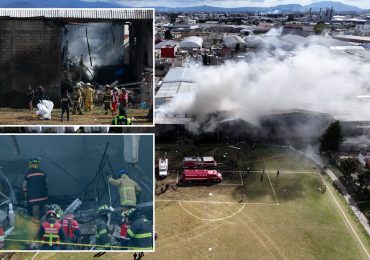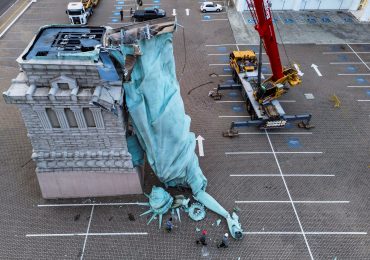THIS is the heartbreaking moment a US weatherman breaks down in tears on live TV after giving a hurricane warning.
One of the longest-tenured TV meteorologists, John Morales was captured on the verge of tears as he warned of Hurricane Milton’s destruction.
NBCThis is the moment veteran TV weatherman John Morales broke down in tears of Hurricane Milton[/caption]
NBCThe emotional Morales was describing the powerful and potentially deadly storm[/caption]
APFamilies have started boarding up their homes[/caption]
GettyPeople fill sandbags in St Petersburg as the state prepares for the arrival of Hurricane Milton[/caption]
The video footage showed an emotional Morales live on a WTVJ telecast, describing the powerful and potentially deadly storm.
Tears welled up and Morales could be heard saying: “Incredible, incredible hurricane.
“I apologize — this is just horrific.”
The emotional weatherman continued to update viewers off-camera, but the emotion could still be heard in his voice.
The heartbreaking clip of the meteorologist was shared on social media platform X (formally Twitter) by NBC news anchor Chris Hush.
He wrote: “An emotional hurricane Milton update from John Morales as the storm hits Cat.5 Status.
“Take this seriously.”
The shaken veteran of TV re-posted Chris’s tweet, and shared how the recent events have changed him.
John said: “I debated whether to share this. I did apologize on the air.”
Grateful viewers flocked to the comments section to leave a message for the weatherman.
One person wrote: Thank you for this. We need more direct communication to express our care and intent for those caught in the wake of these storms’ destruction.”
Another added: “No need to apologize. Thank you for your honesty and willingness to address what so many remain silent on.”
While a third added: You never apologize for being human. You’re a professional doing an amazing job.”
It comes as thousands of people are fleeing Florida as the monster 155mph hurrican barrels towards the state.
Hurricane Milton’s near-record winds and expected storm surge are set to bring destruction to areas already reeling from Helene’s devastation 12 days ago.
The hurricane has been upgraded to category five, and is expected to make landfall in Florida on Wednesday.
More than a million people have been ordered to evacuate from its path – with a further six million put under hurricane-watch warning.
The storm will be the worst to impact the Tampa area in more than 100 years if it stays on the current track, according to the National Weather Service.
Mayor Jane Castor warned the city’s almost 400,000 residents to urgently evacuate.
She told CNN: “I can say this without any dramatization whatsoever: if you choose to stay in one of those evacuation areas, you are going to die.
“This is something that I have never seen in my life and anyone who was born and raised in the Tampa Bay area has never seen this before.”
Florida governor Ron DeSantis said the hurricane is already far stronger than predicted two days ago.
He said: “This is a ferocious hurricane.
“At the strength it is now, this is a really, really strong storm.
“The effects of that, not just from the storm surge but from wind damage and debris, will be really, really significant.
Orlando meteorologist Noah Bergren described the storm as “nothing short of astronomical”.
He wrote on X: “I am at a loss for words to meteorologically describe you the storms small eye and intensity.”
What is a hurricane and how do they form?
A HURRICANE is another name for a tropical cyclone – a powerful storm that forms over warm ocean waters near the equator.
Those arising in the Atlantic or eastern Pacific are called hurricanes, while those in the western Pacific and Indian Ocean are dubbed typhoons or cyclones.
North of the equator they spin anticlockwise because of the rotation of the Earth, however, they turn the opposite way in the southern hemisphere.
Cyclones are like giant weather engines fuelled by water vapour as it evaporates from the sea.
Warm, moist air rises away from the surface, creating a low-pressure system that sucks in air from surrounding areas – which in turn is warmed by the ocean.
As the vapour rises it cools and condenses into swirling bands of cumulonimbus storm clouds.
The system grows and spins faster, sucking in more air and feeding off the energy in seawater that has been warmed by the sun.
At the centre, a calm “eye” of the storm is created where cooled air sinks towards the ultra-low pressure zone below, surrounded by spiralling winds of warm air rising.
The faster the wind, the lower the air pressure at the centre and the storm grows stronger and stronger.
Tropical cyclones usually weaken when they hit land as they are no longer fed by evaporation from the warm sea.
But they often move far inland – dumping vast amounts of rain and causing devastating wind damage – before the “fuel” runs out and the storm peters out.
Hurricanes can also cause storm surges when the low air pressure sucks the sea level higher than normal, swamping low-lying coasts.
ReutersTraffic backs up on Florida highways as residents evacuate[/caption]
NBCJohn Morales was reporting on the storm surge forecast when he broke down[/caption]
NOAAHurricane Milton moves across the Gulf of Mexico heading for Florida[/caption]
NOAAThe storm is expected to make landfall by Wednesday[/caption]
Leave a comment








